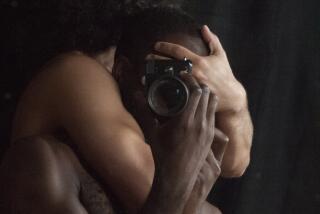Taking Portraits That Have a Professional Touch
- Share via
Your camera is an ideal tool for taking pictures of people, but all of us would like to get something better than snapshots.
The serious photographer calls his people pictures “portraits,” but it is not necessary to have an elaborate studio with multiple lights to shoot a portrait. This can be done anywhere, your own living room or the Gobi Desert in China.
The difference is your skill and artistic ability. My travel assignments around the world require me to come back with strong portraits and I’m glad to share professional secrets.
The most important factor is establishing a rapport with your subject. Do everything possible to put your subject at ease and help him or her forget the sometimes intimidating presence of the camera. Explain that it is best to be natural and not pose. Often it works well to have your model involved with some simple activity such as reading or arranging a vase of flowers.
Get Them Involved
Get people involved with each other when taking portraits and encourage them to interact. A grandfather will wear a special expression when he watches his granddaughter reach for a floating soap bubble. Your wife (or husband) will have an animated face trying out high school French on a Parisian gendarme.
The accepted goal of portraiture is to take a pleasing, even flattering picture of your subject. A smile is always better than a frown. When choosing a subject, select a person with interesting features if there is a choice. Have the person turn his or her head so you can catch light in one eye through the viewfinder of the camera.
Avoid Looking at Sun
Avoid having your model look directly into the sun because that usually will cause him to squint. Electronic flash can be used as a fill light outside if the flash synch speed of your camera is 1/125th of a second or faster. Wrinkles in the neck and under the chin can be minimized by having your subject lift his or her head.
My preference is for the unaltered photographic image, but facial lines can be softened by stretching a nylon stocking over the lens or smearing Vaseline on a clear glass filter. Such image alteration can also be achieved, in much the same manner, when making enlargements in your darkroom.
Large Camera Not Needed
You don’t need a large camera on a tripod. Most photographers use a 35 millimeters single lens reflex (SLR) with a normal or moderate telephoto lens for photographing people. It is more effective to shoot a portrait at a relatively close range, either head and shoulders or just the face.
Avoid wide angle lenses because they tend to distort a person’s features. Whenever possible, I prefer to use natural light, placing the subject so that the light falls on the face in a pleasing way.
Unflattering Shadows
When shooting outdoors I try to avoid midday sunlight, as it tends to cast unflattering shadows. In such a situation it is better to move your model to open shade.
Early morning or late afternoon sunlight is effective; it comes in at a lower angle and provides modeling to the face. Some days are bright and hazy with no direct sunlight, but don’t be discouraged. This type of daylight is the favorite of fashion photographers because it casts no strong shadows.
Light From a Window
For taking portraits indoors, one of the most effective techniques is to move your subject near a window, letting the light fall on the face. It is better if this is soft light instead of direct sun.
You can get an effective profile portrait when a person’s face is turned toward the light. If the subject is facing more directly toward the camera, one side of the face is in shadow and this can necessitate the use of supplementary light for the dark side of the face. The use of supplementary or artificial light brings up the subject of electronic flash or studio flood lights.
Electronic flash is ideal for the traveling photographer because the units are compact, highly portable and can be recharged. They also can give you the correct exposure automatically. Blue floods with clamps or folding stands are better suited to home or studio. In using this type of photographic lighting equipment, you create your own daylight and have the advantage of complete control.
Bounce Light to Soften
In general, it is more satisfactory to bounce your flash or flood against a white surface to soften the light. Direct artificial light can be harsh. It is more effective to use more than one light whenever two or more lights are available.
In addition to the close-up, there is the environmental portrait. This is usually done with a normal or wide-angle lens, but you move back far enough or crop in such a way as to show your subject in his environment. This may be his home, office or any place that makes a statement about him. For instance, a farmer can be photographed with his house and barn in the background.
Whether you are taking portraits indoors or outside, study the face of your subject carefully. Move your subject until the lighting is perfect, wait for the right expression and trip the shutter. It is deciding on that moment that is the essence of portrait photography.


